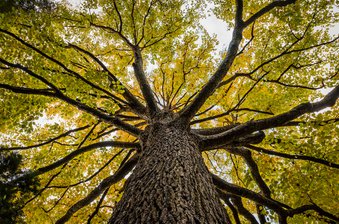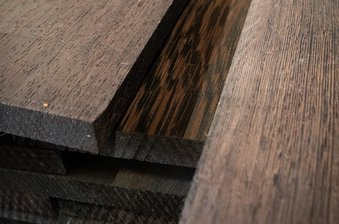Looking to add a touch of natural beauty? As a building material that slots seamlessly into almost any outdoor space, timber’s just the ticket — but no ordinary wood will do.
Whether it’s for cladding, fencing, decking or some DIY garden furniture, the timber needs certain characteristics and qualities — particularly in the UK, where it’s asked to withstand a punishing combination of elements.
Durability should not necessarily be confused with hardness or scratch resistance. A durable wood, primarily, is one that is able to resist the elements and natural forces of decay — this can be caused by moisture that leads to wood-decaying fungus, or by termites that bore into and degrade and destroy the wood.
A good outdoor timber also needs to be stable, not contracting, expanding or warping as a result of changes in temperature and humidity. Durability concerns itself with the heartwood of a tree — the part that contains the extractives that help it to resist these forces of decay — rather than the sapwood, which is much more perishable.
Some timbers used outdoors in high-traffic areas may benefit from high density and scratch resistance. Then there’s how the wood looks, which is of course important and will vary depending on your desired look, with good workability and ease of finishing certainly a nice to have.

What are the best types of wood for outdoor use & garden furniture?
Timbers used externally need to be selected very carefully for their ability to withstand the elements. Explore a few of our favourites — this isn’t an exhaustive list, but you won’t go far wrong with any of these woods!
1. Teak

Everyone’s heard about teak. Perhaps the Rolls-Royce of exterior woods, it’s durable, waterproof, stable and straight-grained, as well as very easy on the eye. Whilst it’s definitely expensive, teak is as close as it gets to perfect, so we’d be remiss to not mention it!
It doesn’t attract dirt and is resistant to insects, allowing it to be left out in the most adverse weather conditions. The fact teak is a traditional wood used for boatbuilding should tell you everything you need to know. For garden furniture DIYers, the wood itself machines beautifully and is a joy to work with.
Teak starts life as a golden medium brown, but over time, will slightly darken. It just gets better with age, much like a fine wine! A once-yearly oil application will help to maintain teak’s gorgeous tones.
Many people are also wary of teak because of its association with unsustainable forestry practices. Make sure you buy yours from a supplier with a clear, unequivocal environmental commitment.
Teak is slightly on the expensive side, which can turn many people away, which is quite understandable. But for the king of outdoor woods, you might find it to be an appropriate cost. You’re ensured of many, many years of service from teak.
If you’re on a little bit of a budget but want superb outdoor timber, you may find that Iroko is more reasonably priced whilst offering similar outdoor performance.
2. Iroko

If teak’s a little bit out of your price range, how about a wood with the moniker ‘African teak’? Iroko is so-called because of its similar appearance and cellular properties.
As well as boasting remarkable scratch resistance, this tropical African hardwood packs in a lot of natural durability to moisture and insect attack. Slow grown in the Ivory Coast region and with a high natural oil content, Iroko very much mimics teak in terms of its strength, durability and lack of maintenance needed.
That’s not to mention its gorgeous, exotic appearance, either. Iroko can start life as a yellow-golden brown timber, darkening over time to stunning rich deeper brown or bronze. Certainly a go-to species for making a luxury statement outdoors.
3. Western Red Cedar

Despite being classified as a softwood, Western Red Cedar is a deceptively high-performance outdoor timber.
Because of the timber’s high resin content, this species offers remarkable natural resistance to insect attack and decay. This, coupled with its gorgeous reddish-browns, make cedar a shoe-in for almost any outdoor application.
‘Thujaplicins’ are the compounds within cedar that are responsible for its natural durability and resistance to insect and fungal attack. These continue to work for many, many years even after the timber has been harvested.
As well as being soft, light and easy to work with, this species doesn’t actually strictly need any treatment before being used outdoors — although be aware that, like any wood, it will slowly weather to a silvery-grey.
Be warned that this timber does have lower density than some of our other suggestions. It’s perhaps best suited for external application as cladding, fencing or any furniture that’s not expected to endure high impact.
4. Alaskan Yellow Cedar

In recent years, Western Red Cedar has increased in price. This may make it slightly out of your budget range, but fear not, there are plenty of alternatives — Alaskan Yellow Cedar being one such wood.
Alaskan Yellow Cedar boasts exceptional outdoor durability, stability and resistance to corrosion and decay — essentially, sharing all the same properties as Western Red Cedar.
If you’re looking to imitate Western Red Cedar’s sought-after appearance but at a lower price, you’ll be pleased to know that Alaskan Yellow Cedar is very easy to treat; a tinted stain can make it look very much like its Western Red cousin!
5. Douglas Fir

Despite its softwood status, fir is surprisingly solid — one of the hardest softwoods, in fact! Not only this, but like cedar, it contains naturally-occuring resin that provides it with good protection against decay and fungal attack.
Since it’s widely available, fir can be useful for those running a slightly tighter budget. It’s one of the cheapest woods for outdoor use. If you’re a woodworker or DIY garden furniture maker, this species also works and machines well, in addition to holding finishes easily — whether a clear varnish, stain or paint.
As well as this functional performance, this Canadian timber’s characterful wild grain has won it many fans. Coupled with its ease of finishing, this species is a go-to wood for any outdoor space.
6. European Oak

Oak is a mainstay structural timber, commonly used for oak-framed buildings. This should tell you everything you need to know about its outdoor performance qualities, as well as its hard-wearing nature.
Not only is oak strong, durable and sturdy, it’s undeniably gorgeous. It’s no surprise why European Oak has stood the test of time — that classic, versatile golden-medium brown colour never goes out of style and works in any outdoor environment.
An excellent hardwood choice, oak garden furniture does require occasional protective treatment, as well as a covering when not in use (ideally). Sealing the wood will help to prevent moisture getting in, protecting the wood from warping. Some people may find the price to be slightly prohibitive, too.



Outdoor wood & garden furniture maintenance tips
Treatment
If you choose durable species (such as those listed above), the timber’s natural resins will protect it to a large extent. That said, applying a clear sealant or woodcare finish will enhance its lifetime and provide double-lock protection from the elements.
Treatment will also help your wood to retain its original colour as a result of photo-degradation (more commonly known as ‘weathering’!), caused by the sun’s UV. This happens to all woods, albeit at different speeds depending on the species.
Increasingly, many outdoor designers and architects are looking for wood that attains the rustic silvery-grey look. If the ‘silver fox’ style is something you’re digging, applying a colourless, waterproof protection (like Owatrol H4 Wood) will allow your outdoor wood to slowly turn grey whilst protecting it from any moisture and insect damage.
Of course, be sure to follow the product manufacturer’s guidelines — a reapplication every couple of years is usually advised.
Ongoing care
The most troublesome outdoor elements for our timber are direct rain, snow, ice and sunlight. Therefore, when not in use or you’re expecting a spot of adverse weather, if possible consider covering your furniture, perhaps with a sheet. If your wood’s already wet, don’t be tempted to dry it artificially with heat.
Be sure to give your wood a gentle clean down to remove dirt, perhaps at the beginning of spring ahead of seasonal use. This should be done with some warm water, soap and a bristle brush. This is best done on a sunny day, allowing the furniture to fully dry out.


Got an outdoor project in mind?
Sawn timber, cladding, fencing, decking — we provide a range of timber products and have been helping customers to meet their varied timber requirements since 1957. We import a range of the world’s gorgeous, durable, dynamic timber species.
If you’re looking to get cracking on your next outdoor project, click the enquiry button below to contact our friendly team. We’d be delighted to help!
If you’re nearby, pop in to cast their eyes over our sought-after selection of wood! We’re just off the A1 near Ripon, in Melmerby.







